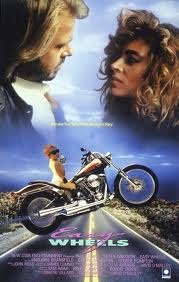Friday, October 26, 2012
YEAR 1991: V.I. WARSHAWSKI
The main point of interest in the film V.I. WARSHAWSKI-- a critical and commercial flop in its day-- is that it might be considered a minor herald of the burgeoning "tough heroine" subgenre that proliferated during this decade.
I haven't read the source-novel by Sara Paretsky, so I can't make an extended comparison. All I remember is that though Kathleen Turner looked great in the role-- garnering what few raves the film got-- the rendition was just another generic Hollywood action-opus, failing to underscore any of the Warshawski character's particular concerns with women's issues.
It does have one kickass scene where Turner's Warshawski has to take a beating from a low-grade thug before she manages to turn the tables on him. Quite a change from the days of the old serials, where heroines almost instantly fainted the first time a bad guy pushed them to the floor.
Saturday, October 20, 2012
YEAR 1990: BREATHLESS MAHONEY
At the risk of pissing off any readers who haven't seen the 1990 Warren Beatty-Madonna DICK TRACY, I'm spoiling the ending: the mysterious masked mastermind known as "the Blank" is none other than Madonna's character Breathless Mahoney.
As noted in my writeup of the comic-strip Breathless, the original character was something less than a high-roller. She's not even a major seductress as per the then-current Madonna personality (not that Chester Gould created a lot of seductress-types). There's nothing much in common between the original and the film-version except the name. It may one of the few times, if not the only time, that a secondary medium improved on not one but two of DICK TRACY's classic villains.
For most of the film, Breathless seems to be one of the typical "bad girls" of film noir, set to tempt the hero-- Dick Tracy in this case-- from his loyalty to a pretty-but-not-glamorous "good girl." Breathless does a pretty good job of keeping Beatty's Tracy "out of breath," but her role in the story seems tangential to Tracy's war on the criminal forces of Big Boy Caprice (Al Pacino) and his many strip-derived allies: Flat Top, Itchy, Prune Face, etc. At the same time Tracy also has to contend with a mysterious blank-faced man trying to take over Caprice's criminal empire. Surprise ending: when it all shakes out, behind the Blank's mask is the face that launched a thousand, uh, fans.
The plot never expands on what motivated Breathless to become a supervillain. However, there is one crucial scene that proves suggestive: after Big Boy takes over the club where Breathless performs, the goony-looking gangster not only takes charge of her career but tries to tell her how to perform as well. That sounds like good enough motivation to turn to crime right there.
I mentioned that the film does two DICK TRACY villains better than the originals, by which I meant that the original Blank, while interesting (and male), is something less than one of the classic Tracy villains.
Wednesday, October 17, 2012
YEAR 1989: THE WOMEN OF THE WOLF
1989 is rather a dub year for femmes formidables, but the comic biker-flick EASY WHEELS deserves to be a bit better-known.
In this deadpan-comic twist on such serious-toned lady-biker films as SHE-DEVILS ON WHEELS and THE MINI-SKIRT MOB, Sam and Ivan Raimi, along with director David O'Malley, introduce the audience to "She-Wolf" (Eileen Davidson), a woman raised by wolves. When she grows to adulthood She-Wolf goes the Pussy Galore route and assembles an all-female biker-gang around her, "The Women of the Wolf." Implicitly they have Lesbian Nation ambitions, for they steal babies after the manner of the archaic Amazons, selling the male babies to illegal adoption agencies and allowing the girl babies to be raised by the wolfpack, as She-Wolf was.
The Wolf-Women have everything going for them until they run across a gang of all-male bikers, whose name, "The Born Losers," contains more truth than poetry. The guys aren't much of a physical threat to the lady bikers, who kick the guys' butts in two separate encounters. Rather, their presence threatens the stability of the group when She-Wolf unintentionally strays from the Isle of Lesbos and falls in love with the Loser-leader Bruce (Paul LeMat).
EASY is pretty tame material, but it sports some nice light-hearted brawls. Sam Raimi would gain greater fame in the Femme Formidable department about six years later when he produced the XENA teleseries.
Wednesday, October 10, 2012
YEAR 1988: THE WHITE WORM
Thus far, this is the only major media adaptation of Bram Stoker's mostly forgotten THE LAIR OF THE WHITE WORM, of which I made brief mention for Year 1911 in THE PREHISTORY OF THE FEMME FORMIDABLE.
Unfortunately, though the Stoker novel is something of a mess, Ken Russell's adaptation is overly jokey and derisive of the source-material. Amanda Donohue makes an appealing enough snake-woman, but that's about all I can remember from this old chestnut. I confess I haven't seen it in about 20 years, however. Perhaps time might prove kinder to the film now.
Sunday, October 7, 2012
YEAR 1987: THE KNIGHT SABERS
As noted elsewhere Japan proved itself a worthy successor to the US in terms of creating iconic femmes formidables. One of the best known femme-centric products of the boom years of the manga/anime juggernaut of the 1980s was the OVA series BUBBLEGUM CRISIS, featuring four female mercenaries known as the Knight Sabers.
As shown above the four women-- Sylia, Priss, Linna, and Nene-- donned body armor in order to fight the destructive androids unleashed upon the MegaTokyo of 2032 by the corrupt Genom corporation. The four women were reasonably well characterized for such a fast-paced sci-fi adventure. CRISIS patterned elements of its future scenario from the film BLADE RUNNER, though a spinoff franchise, A.D POLICE FILES, was much closer to the dramatic tone of the Ridley Scott film.
Subscribe to:
Posts (Atom)





